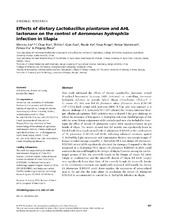| dc.contributor.author | Liu, Wenshu | en_US |
| dc.contributor.author | Ran, Chao | en_US |
| dc.contributor.author | Liu, Zhi | en_US |
| dc.contributor.author | Gao, Qian | en_US |
| dc.contributor.author | Xu, Shude | en_US |
| dc.contributor.author | Ringø, Einar | en_US |
| dc.contributor.author | Myklebust, Reidar | en_US |
| dc.contributor.author | Gu, Zemao | en_US |
| dc.contributor.author | Zhou, Zhigang | en_US |
| dc.date.accessioned | 2017-04-27T11:49:02Z | |
| dc.date.available | 2017-04-27T11:49:02Z | |
| dc.date.issued | 2016-08 | |
| dc.Published | Liu W, Ran, Liu Z, Gao, Xu, Ringø E, Myklebust R, Gu, Zhou Z. Effects of dietary Lactobacillus plantarum and AHL lactonase on the control of Aeromonas hydrophila infection in tilapia. MicrobiologyOpen. 2016;5(4):687-699 | eng |
| dc.identifier.issn | 2045-8827 | |
| dc.identifier.uri | https://hdl.handle.net/1956/15724 | |
| dc.description.abstract | This study addressed the effects of dietary Lactobacillus plantarum or/and N-acylated homoserine lactonase (AHL lactonase) on controlling Aeromonas hydrophila infection in juvenile hybrid tilapia (Oreochromis niloticus♀ × O. aureus ♂). Fish were fed Lb. plantarum subsp. plantarum strain JCM1149 (108 CFU/g feed) or/and AHL lactonase AIO6 (4 U/g) and were exposed to a chronic challenge of A. hydrophila NJ-1 (105 cells/mL) for 14 days. Intestinal (foregut) alkaline phosphatase (IAP) activities were evaluated 1 day post challenge to reflect the resistance of fish against A. hydrophila infection. Parallel groups of fish with the same dietary assignments while unchallenged were also included to investigate the effect of dietary Lb. plantarum or/and AIO6 supplementation on gut health of tilapia. The results showed that IAP activity was significantly lower in fish fed with diets supplemented with Lb. plantarum JCM1149 or the combination of Lb. plantarum JCM1149 and AIO6, indicating enhanced resistance against A. hydrophila. Light microscopy and transmission electron microscopy images of foregut revealed damage caused by A. hydrophila NJ-1, but dietary Lb. plantarumJCM1149 or/and AIO6 significantly alleviated the damages. Compared to the fish immersed in A. hydrophila NJ-1, dietary Lb. plantarum JCM1149 or AIO6 could maintain the microvilli length in the foregut of tilapia. However, among the unchallenged groups of fish, the microvilli length in the foregut of tilapia fed AIO6 (singly or combination) and the microvilli density of tilapia fed AIO6 (singly) were significantly lower than those of the control, though the microvilli density in the combination treatment was significantly improved. Additionally, the dietary Lb. plantarum JCM1149 could down-regulate the expression of stress-related gene in the gut after the acute phase. In conclusion, the dietary Lb. plantarum JCM1149 is recommended to control the A. hydrophila infection in tilapia. | en_US |
| dc.language.iso | eng | eng |
| dc.publisher | Wiley | eng |
| dc.rights | Attribution CC BY | eng |
| dc.rights.uri | http://creativecommons.org/licenses/by/4.0/ | eng |
| dc.subject | AHL lactonase | eng |
| dc.subject | disease | eng |
| dc.subject | immunity | eng |
| dc.subject | lactobacillus | eng |
| dc.subject | tilapia | eng |
| dc.title | Effects of dietary Lactobacillus plantarum and AHL lactonase on the control of Aeromonas hydrophila infection in tilapia | en_US |
| dc.type | Peer reviewed | |
| dc.type | Journal article | |
| dc.date.updated | 2017-02-21T13:31:57Z | |
| dc.description.version | publishedVersion | en_US |
| dc.rights.holder | Copyright 2016 The Author(s) | |
| dc.identifier.doi | https://doi.org/10.1002/mbo3.362 | |
| dc.identifier.cristin | 1361347 | |
| dc.source.journal | MicrobiologyOpen | |

